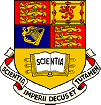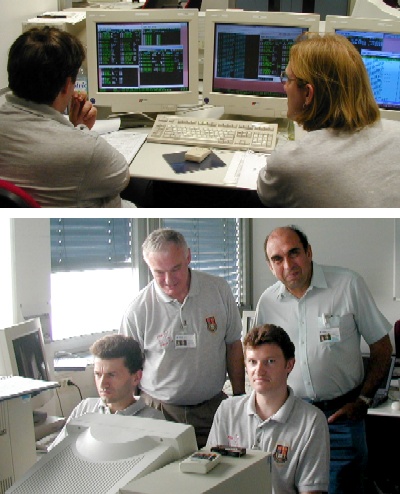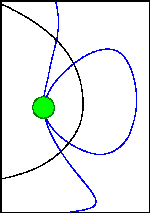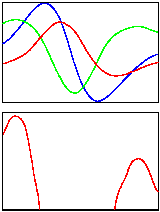
 |
|
News Page |

September 2000 |
This month's news stories:Cluster Switch-OnCluster First Data |
 Cluster: "We have a mission !"
Cluster: "We have a mission !"We are happy to report on a very important event in the life of the group, the successful start of operations in space of the magnetic field investigation led by our group, on the European Space Agency's four-spacecraft Cluster mission. Cluster, having risen from the ashes after the destruction of the first four spacecraft in 1996, is the most important space mission for understanding the detailed physical processes in the Earth's magnetosphere.
After a tiring, but highly successful week of work at the European Space Operations Centre in Darmstadt, Germany, the Imperial College team responsible for the Cluster Magnetic Field Investigation (FGM) has now completed the in-flight commissioning of the four instruments on the four Cluster spacecraft. The team consisted of Chris Carr, Technical Manager, Julian Harris and Patrick Brown, Instrument Engineers, Tim Oddy, Software Engineer, and André Balogh, Principal Investigator. The instrument switch-on and checkout was conducted by Julian and Patrick (top picture), under Chris' supervision. Tim retrieved the science data as received from the instrument. The Imperial College team was supported at ESOC by Mario Acuña, from the Goddard Space Flight Center, who had provided the four pairs of sensors, and Karl-Heinz Fornacon, from the Technische Universität, Braunschweig, who assisted with the on-line calibration of the instruments. The second picture shows André, Mario, Tim and Chris. The commissioning was supported by the Cluster Operations Team at ESOC, Colette Pullig, Sandro Matussi and Mischa Schmidt.
Data from the instruments were transferred from Darmstadt to Imperial College, where Malcolm Dunlop supervised the processing of the data, supported by Edita Georgescu in the Max-Planck Institut für Extraterrestrische Physik in Garching, Germany.
The first to be switched on and commissioned was the instrument on Cluster 3, on Tuesday 22 August, followed by, on the same evening, the instrument on Cluster 1. The next evening it was the turn of the instrument on Cluster 2, and on Thursday, 24 August, the last instrument, on Cluster 4, was switched on and commissioned. Shortly after the switch-on of this last instrument, when it became clear that it was also providing excellent quality data from space, Chris Carr announced that "We have a mission !" Indeed, with the four working magnetometers on the four Cluster spacecraft in their close by orbits, we can see our hopes for a quantum leap in space physics fulfilled, as the observations will lead to the solution of many unsolved problems in the Earth's space environment. There has never been a mission like Cluster and we are proud to be the first to start operations.
André Balogh 9th September 2000

The magnetometers (FGM) on the four Cluster spacecraft were successfully commissioned in flight on 22 to 24 August. Cluster's eccentric elliptical orbit currently has an apogee deep in the tail of the Earth's magnetosphere, right behind the Earth, in such a way that the spacecraft quartet is eclipsed for several hours by the Earth. Perigee, however, is on the sunlit side of the Earth, close to the noon meridian. This means that as the spacecraft swing around the Earth's dayside, they traverse, on either side of perigee, the regions of the magnetosphere known as the cusps, where the configuration of the magnetosphere has a funnel-like opening, accessible to the entry of solar wind plasma. In about six months, Cluster's apogee will be in the sunward direction from the Earth, when the external cusps will be subject to observations by the whole payload. These observations represent one of the primary objectives of the mission.
Although the Cluster instruments, as a whole, are still being commissioned, and the scientific operation of the mission will only start when the payload has been commissioned, the FGM instruments already provide data when scheduled within the commissioning operations. In fact, even before the last FGM instrument, on Cluster 4, was commissioned late on 24 August, the first three provided simultaneous data around perigee on that day which occurred shortly after 0900 GMT. Given Cluster's orbit, it was not surprising, but still very satisfactory, that the three magnetometers on spacecraft 1, 2 and 3 observed clear magnetic signatures in the cusps.
 The first figure shows the orbit of the spacecraft around perigee on the 24 August, as well as an enlarged representation of the tetrahedral configuration of the four spacecraft. The second figure shows, in the upper panel, the three components of the magnetic field measured by FGM on spacecraft 2 through the perigee pass, while in the lower panel, we show the component of the magnetic field aligned with the spin axis on all three spacecraft. The strong disturbances visible shortly after 0730 and between 1030 and 1100 GMT correspond to the signatures of currents associated with the cusps, distorting the otherwise smooth geomagnetic field. The earlier crossing happened exactly where the southern cusp was expected, while the later event was more of a glancing encounter, due to the relative inclination of the orbit and of the Earth's dipole at the time.
The first figure shows the orbit of the spacecraft around perigee on the 24 August, as well as an enlarged representation of the tetrahedral configuration of the four spacecraft. The second figure shows, in the upper panel, the three components of the magnetic field measured by FGM on spacecraft 2 through the perigee pass, while in the lower panel, we show the component of the magnetic field aligned with the spin axis on all three spacecraft. The strong disturbances visible shortly after 0730 and between 1030 and 1100 GMT correspond to the signatures of currents associated with the cusps, distorting the otherwise smooth geomagnetic field. The earlier crossing happened exactly where the southern cusp was expected, while the later event was more of a glancing encounter, due to the relative inclination of the orbit and of the Earth's dipole at the time.
Even if this first passage through the cusps of the magnetosphere was unplanned, in scientific terms, and the instrument from the fourth spacecraft was only switched later that day, the lucky preview of one of the most interesting regions of the magnetosphere by the three FGM instruments is the first glimpse by Cluster of one of its primary objectives. We are now studying the detailed, high-resolution magnetic field data from this passage through the cusps, as such measurements have never before been made in this region. As Cluster's orbit will now swing away from this region, we shall not revisit the cusps for another six months. We are looking forward to vast volumes of new data from all four spacecraft and from the other instruments by then to exploit this unique mission.
André Balogh, Malcolm Dunlop and the Cluster FGM team, 9th September 2000
View Last month's news, older news or return to Space and Atmospheric Physics home page